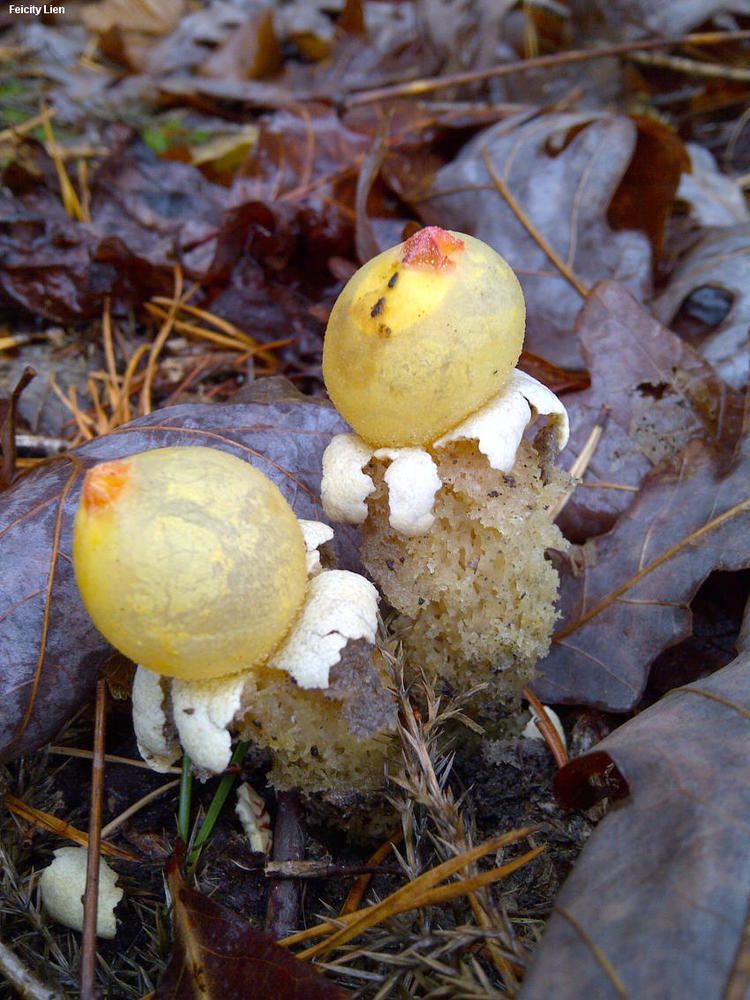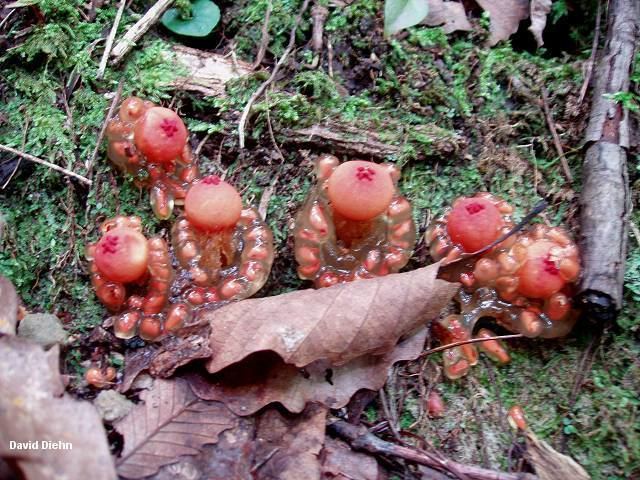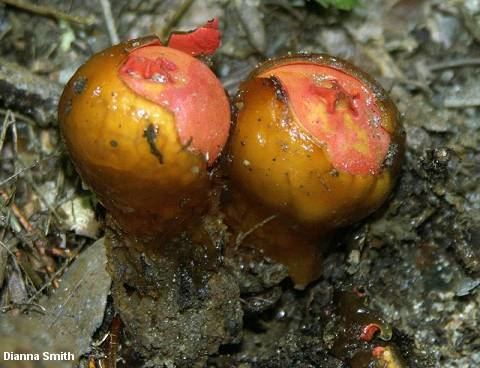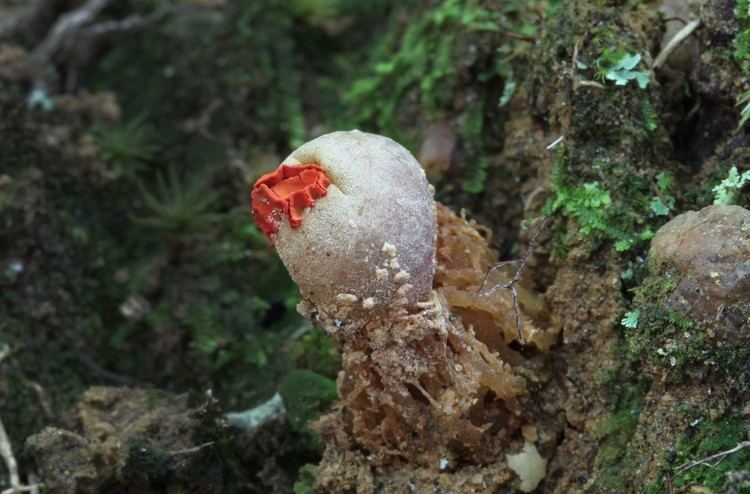Kingdom Fungi Class Agaricomycetes Rank Genus | Division Basidiomycota | |
 | ||
Similar Calostoma cinnabarinum, Sclerodermataceae, Sclerodermatineae, Boletales, Astraeus | ||
This is why i hike alone series calostoma cinnabarina long stalked puffball
Calostoma is a genus of 29 species of gasteroid fungi in the suborder Sclerodermatineae. Like other gasteroid fungi, Calostoma do not have the spore discharge mechanism associated with typical gilled fungi (ballistospory), and instead have enclosed spore-bearing structures. Resembling round, orange to red gelatinous puffballs on thick stalks, species have been collected in regions of deciduous, temperate, tropical or subtropical forests. They have a worldwide distribution, including eastern North America, Asia, and Australasia. The common name given to some species, "prettymouth", alludes to the bright red fruit bodies with openings that may somewhat resemble lips.
Contents
- This is why i hike alone series calostoma cinnabarina long stalked puffball
- Esec ae basiodiomycetes calostoma
- Taxonomy
- Description
- Spores
- Development
- Habitat and distribution
- Edibility
- Bioactive compounds
- Species list
- References

The unusual fruit body structure has historically led mycologists to suggest various classification schemes based on presumed relationships to other puffball or "stomach mushrooms". Phylogenetic analyses performed in the 2000s show the genus to be evolutionarily related to the Bolete mushrooms. Calostoma species are ectomycorrhizal, forming symbiotic associations with trees from various families. The type species, Calostoma cinnabarinum, is ectomycorrhizal with oak.

Esec ae basiodiomycetes calostoma
Taxonomy

The original genus description, based on the type species Calostoma cinnabarinum (synonymous with cinnabarina), was published by French botanist Nicaise Auguste Desvaux in 1809. Before the advent of modern genetic analysis, the Calostoma was considered to be part of the Gasteromycetes, a grouping of fungi with enclosed spore-bearing structures. Specifically, it was classified in the order of stalked puffballs, although some mycologists have suggested that the genus Calostoma should be merged with Tulostoma (xerophilic stalked puffballs), Scleroderma (hard puffballs), Geastrum (earthstars), or Pseudocolus (stinkhorns). Some authors have placed Calostoma in its own family, the Calostomataceae.

In the 2000s, a phylogenetic analyses using nuclear and mitochondrial ribosomal gene sequences helped to clarify the phylogeny of Calostoma. Using the species C. cinnabarinum and C. ravenelli as representative examples, the research showed the genus evolutionarily related to the monophyletic Boletales clade, and separate from clades containing most of the gilled mushrooms, puffballs, stalked puffballs, earthstars, stinkhorns and non-bolete Gasteromycetes. Calostoma belongs to the suborder Sclerodermatineae in the Boletales order. The Boletales comprise the following genera: Boletinellus, Calostoma, Gyroporus, Phlebopus, Pisolithus, Scleroderma, and Veligaster. Calostoma is thought to have diverged evolutionarily from the other Boletales between 52–115 million years ago.

The genus name Calostoma is derived from the Greek kallos or "beauty", and stoma (στóμα) or "mouth"; similarly, several species are referred to in the vernacular as "prettymouths". In Korea, it is called Yongi, or "red cheeks".
Description
Fruit bodies, technically known as gasterocarps, form spherical spore-bearing heads with a peridium (outer tissue layer) made of two to four clearly defined layers of tissue. The outermost peridial layer is a thick gelatinous or shiny cuticle, which during maturity peels away to reveal the brightly colored peristome that has a star-shaped pore through which spores may escape. The innermost layer of the peridium is papery and membranous, and remains attached to the outer layers only at the apex of the star-shaped apical pore or slit. The fruit bodies may either have no stalk (sessile), or be atop a stalk. The stalk, made of thick, intertwined and fused cords of hyphae, is hygroscopic, and will expand upon absorbing moisture. The spore mass in the head, the gleba, is pale, and initially has thick-walled skeletal hyphae called capillitia. Clamp connections are present in the fungal hyphae.
Spores
The spores are spherical to elliptical in shape, and typically have surfaces that are reticulate (with interconnected grooves resembling a net) or pitted. The variations in the elaborate pitted-spore reticulations have inspired investigation with techniques such as scanning electron microscopy and atomic force microscopy. The latter technique was used to distinguish subtle details (at the nanometer scale) and differences in the fine structure of the spores of various Calostoma species. The spore reticulations have purpose: they become entangled and interwoven with nurse cells and scaly hyphae, the net effect of which is to prevent the spores from being blown away simultaneously.
Development
When grown in humid conditions, such as might typically be found in a temperate deciduous forest, Calostoma species develop a thicker, more gelatinous exoperidium (the outermost peridial layer). As the stalk expands, the exoperidium becomes sloughed off, exposing the endoperidum and a raised peristome—the ridge of tissue around the opening suggestive of the common name, "prettymouth". The exoperidium may help to protect the maturing gleba of late-fruiting species from harmful variations in temperature or humidity, or from insect predation.
Habitat and distribution
The species in Calostoma have been collected in regions of deciduous, temperate, tropical or subtropical forests, containing tree species from the families Fagaceae, Nothofagaceae, Myrtaceae, and Dipterocarpaceae. The type species C. cinnabarinum was shown to form ectomycorrhizae with Quercus species, using isotopic labeling, molecular and morphological analyses. Southeast Asian Calostoma have also been described as ectomycorrhizal. Calostoma sarasinii forms ectomycorrhizae with species of Lithocarpus (Fagaceae) while Calostoma retisporum forms ectomycorrhizae with species from the Myrtaceae. The ectomycorrhizal mode of nutrition is predominant in the Sclerodermatineae suborder. Historically, it had been assumed to be saprobic, due to its taxonomic uncertainly, and presumed relatedness to other saprobic fungi like the stalked puffballs and the earthstars.
The distribution of the genus is limited to Australasia (Australia, New Zealand, Papua New Guinea), Southeast Asia, Asia, and North and Central America. Species have been described from Indonesia (Borneo, Java, Sumatra, New Guinea), Ceylon, Himalaya, Nepal, Taiwan, China, New Zealand, North America, and Latin America. Australian species include C. fuhreri, C. fuscum, C. insigne, C. rodwayi, and C. viride. David Arora mentions a preference for humid forests in eastern North America, particularly in the southern Appalachian Mountains.
Edibility
In general, Calostoma species are not considered edible; because they typically begin their development underground, by the time fruit bodies appear they are too tough for consumption. However, a 2009 study reported that in the community of Tenango de Doria (Hidalgo state, Mexico), Calostoma cinnabarinum used to be collected by children and consumed "like a tidbit", although the tradition seems to have been abandoned in recent years. Locals called the young fruit bodies "yemitas".
Bioactive compounds
Calostoma cinnabarinum contains a pigment named calostomal that is responsible for its red color. The chemical structure is all-trans-16-oxohexadeca-2,4,6,8,10,12,14-heptaenoic acid.
Species list
The following species list is compiled from Index Fungorum as well as species published in the literature, but missing in Fungorum, specifically C. formosanum, C. junghuhnii, and C. sarasinii. The name listed under the species binomial is the authority—the author of the original description of that species, followed by the year of publication.
